Search
You are here
The menhirs of Belz, discovery and extensive excavation of a Mesolithic ensemble in Morbihan: a first in France
Inscribed in the landscape, menhirs and arrangements of upright stones make the Morbihan a favoured region for the study of megalithic monuments. The colossal forms of Carnac constitute the most emblematic example of this architecture, representing the Neolithic societies of the 5th to 3rd millennia BC. Today's breaking news today comes from Belz, where around 50 menhirs have recently been discovered.
Chronicle of site
Post date
29 June 2006
Last modified
10 February 2017
In the context of a housing development project at the site of Kerdruelland (Belz), an excavation is being conducted by a team from the Institut National de Recherches Archéologiques (Inrap), under the direction of the Regional Direction of Cultural Affairs (Regional Service of Archaeology). This extensive excavation of 3000 m is the first of its type in France concerning megaliths. It allows us to expand our knowledge of the construction and organization of these menhirs, as well as their history.
The site has revealed a large quantity of remains: granite blocks, networks of ditches, wall foundations, pits, scatters of small stones…
Two human occupations have been identified through analyses of worked flints and pottery shards: one from the Late Neolithic (2nd millennium BC), the other from the Medieval period.
The site has revealed a large quantity of remains: granite blocks, networks of ditches, wall foundations, pits, scatters of small stones…
Two human occupations have been identified through analyses of worked flints and pottery shards: one from the Late Neolithic (2nd millennium BC), the other from the Medieval period.
Rediscovering the archaeological levels
One of the major interests of the megalithic alignment of Belz is that it is preserved in its original sedimentary environment. At Carnac, for example, most of the Neolithic levels have disappeared. For archaeologists, these levels contain very important information concerning the environment of the monument and the different human actions that took place there, from the construction to the abandon of this architecture
A prehistoric "iconoclasm”?
Several menhirs were simply pushed over and now lie on the ground near the pit in which they were implanted. Others were moved from their original location and show numerous traces of debitage (working). The megaliths of Belz were probably overturned as early as the Late Neolithic. During the Middle Ages, agricultural exploitation of this land led to the working and utilization of the toppled blocks.
This is not the first dismantling of Neolithic megaliths known in Armorica. The great menhirs of Locmariaquer, from the 5th millennium, were segmented during the 4th millennium and reused in certain dolmens, such as on the island of Gavrinis. The probable destruction of the Belz menhirs during the 3rd millennium confirms the evolution of mentalities during this period.
This is not the first dismantling of Neolithic megaliths known in Armorica. The great menhirs of Locmariaquer, from the 5th millennium, were segmented during the 4th millennium and reused in certain dolmens, such as on the island of Gavrinis. The probable destruction of the Belz menhirs during the 3rd millennium confirms the evolution of mentalities during this period.
Proceedings for classification as a historic monument
Due to the scientific and patrimonial interest of this discovery, the Ministry of Culture and Communication decided to institute the procedure of classifying this ensemble of megaliths and the surrounding parcels as a historic monument.
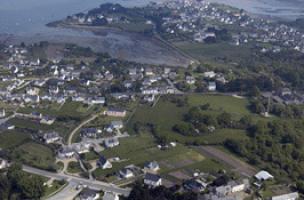
Situation du site archéologique au bord de la rivière D'Etel.
© H. Paitier/Inrap
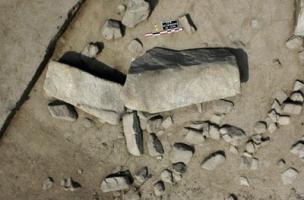
Vue zénithale d'un bloc et d'éclats de débitage.
© H. Paitier/Inrap
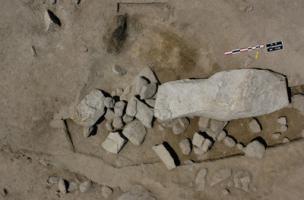
Vue zénithale d'un menhir couché et de son calage.
© H. Paitier/Inrap
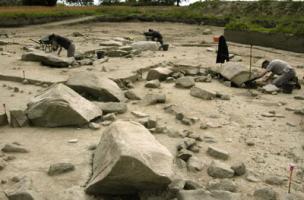
Vue du site en cours de fouille.
© H. Paitier/Inrap
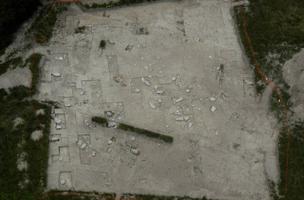
Vue aérienne du site en fin de fouille.
© H. Paitier/Inrap
Site Director : Stéphan Hinguant, Inrap - Christine Boujot UMR 6566 du CNRS
Curation : Regional Service of Archaeology (Drac Brittany)
Developers : Housing development
Contact(s) :
Mahaut Tyrrell
Media communication
Inrap, media partnerships and relations
+33 6 07 40 59 77
mahaut.tyrrell [at] inrap.fr

